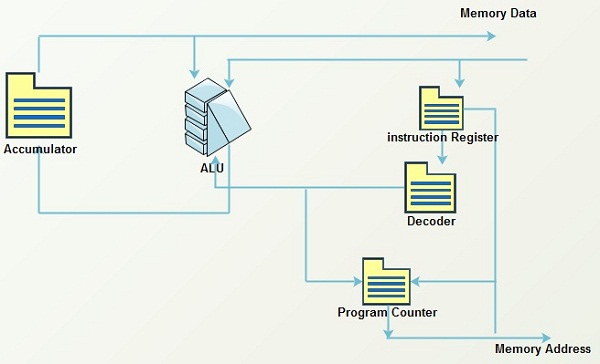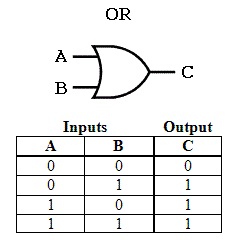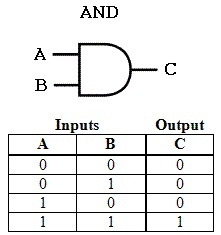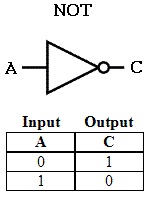Arithmetic Logic Unit (ALU): A sub unit within a computer’s central processing unit. ALU full form is Arithmetic Logic Unit , takes the data from Memory registers; ALU contains the logical circuit to perform mathematical operations like subtraction, addition, multiplication, division, logical operations and logical shifts on the values held in the processors registers or its accumulator.
It is the size of the word that the ALU can handle which, more than any other measure, determines the word-size of a processor: that is, a 32-bit processor is one with a 32-bit ALU.
After processing the instructions the result will store in Accumulator. Control unit generates control signals to ALU to perform specific operations. The accumulator is used as by default register for storing data. It is 16-bit register.
The simplest sort of ALU performs only addition, Boolean logic (including the NOT or complement operation) and shifts a word one bit to the right or left, all other arithmetic operations being synthesized from sequences of these primitive operations. For example, subtraction is performed as complement-add multiplication by a power of two by shifting, division by repeated subtraction. However, there is an increasing tendency in modern processors to implement extra arithmetic functions in hardware, such as dedicated multiplier or divider units.
The ALU might once have been considered the very core of the computer in the sense that it alone actually performed calculations. However, in modern SUPER SCALAR processor architectures this is no longer true, as there are typically several different ALUs in each of several separate integer and floating-point units. An ALU may be required to perform not only those calculations required by a user program but also many internal calculations required by the processor itself, for example to derive addresses for instructions that employ different ADDRESSING MODES, say by adding an offset to a base address. Once again, however, in modern architectures there is a tendency to distribute this work into a separate load/store unit.
The three fundamental attributes of an ALU are its operands and results, functional organization, and algorithms.
Operands and Results
The operands and results of the ALU are machine words of two kinds: arithmetic words, which represent numerical values in digital form, and logic words, which represent arbitrary sets of digitally encoded symbols. Arithmetic words consist of digit vectors (strings of digits).
Operator: Operator is arithmetic or logical operation that is performed on the operand given in instructions.
Flag: ALU uses many types of the flag during processing instructions. All these bits are stored in status or flag registers.
We’ll be covering the following topics in this tutorial:
Functional Organization of an ALU
A typical ALU consists of three types of functional parts: storage registers, operations logic, and sequencing logic.
Arithmetic Logical Unit (ALU) Architecture
ALU is formed through the combinational circuit. The combinational circuit used logical gates like AND, OR, NOT, XOR for their construction. The combinational circuit does not have any memory element to store a previous data bit. Adders are the main part of the arithmetic logic unit to perform addition, subtraction by 2’s complement.
Control unit generates the selection signals for selecting the function performed by ALU.
Registers : Registers are a very important component in ALU to store instruction, intermediate data, output, and input.

Logic Gates
Logic gates are building a block of ALU. Logic gates are constructed from diode, resistors or transistors. These gates are used in Integrated circuit represent binary input as ‘ON’ and ‘OFF’ state. Binary number 0 is represented by ‘OFF’ and Binary Number ’1’ is represented by ‘ON’ state in an integrated circuit.
OR gate : OR gate can take two or more inputs. The output of OR gate is always 1 if any of the inputs is 1 and 0 if all the inputs are false. OR gate performs an addition operation on all operand given in instructions. It can be expressed as X=A+B or X=A+B+C.

AND gate : AND gate takes two or more inputs. The output of AND gate is 1 if all inputs are 1. AND gate gives 0 results if any one of input in given data is 0. AND gate performs multiplication option on all inputs operands. It is represented by ‘.’ symbol. We can write it as- X=A.B or X=A.B.C.

NOT gate : Not gate is used to reverse the result of gates or reverse Boolean state from 0 to 1 and 1 to 0.Not gate is also used with ‘AND’ and ‘OR’ gate. While using with AND or ‘OR’ gate, NOT gate is representing an as small circle in front of both gates. After using NOT gate, AND gates convert into NAND or ‘OR’ gate convert into NOR.

Registers: Registers provide fast memory access as a comparison to cache, RAM, hard disk. They are built on CPU. Register are small in size. Processing Intermediate data stored in registers.A number of registers used for specific purpose. ALU used four general purpose register. All these four registers are 16-bit register is divided into registers. 16-bit register implies that register can store maximum 16 bit of data.
Accumulator : Accumulator is 16 bit by default and general purpose register. By default means that any operand in instruction does not specify a particular register for holding the operand. That time operand will automatically store in AC. AC is used as two separate registers of 7 bit AL and AH. AC located inside the ALU. Intermediate data and result after execution will store in AC.AC used MBR to deal with memory.
Program Counter: PC stands for program counter. It is 16-bit register. It counts the number of instruction left for execution. It acts as a pointer for instructions and also known as Instruction pointer register. PC holds the address of next instruction to be executed. When an instruction is fetched from the register. Register get automatically incremented by one and point to the address of next instruction.
Flag register : it is also known as a Status register or Program Status register. Flag register holds the Boolean value of status word used by the process.
Auxiliary Flag : if two numbers are to be added such that if in the beginning of higher bit there is a carry. This is known as auxiliary bit.
Carry bit : Carry bit is indicate the most significant borrow or carry bit by subtracting a greater number than a smaller number or adding two numbers.
Sign Bit : Sign bit is a most significant bit in 2’s complement to show that result is negative or positive. It is also known as negative bit. If the final carry over here after the sum of last most significant bit is 1, it is dropped and the result is positive.
If there is no carry over here then 2’s complement will negative and negative bit set as 1.
Overflow bit : Overflow bit used to indicate that stack is overflow or not after processing the instruction. It is set to be 1 means that stack is overflow if it is 0 then its reverse to happen.
Parity Bit : Parity bit represent odd or even set of ’1’ bits in given string. It is used as error detecting code. Parity bit has two types: Even parity bit and an Odd parity bit.
In Even parity bit, we count the occurrence of I’s in the string. If a number of 1 bit is odd in counting than we will add even parity bit to make it even or if the number of 1 bit are even then even parity bit is 0.
Data Number of 1 bits even parity bit Data including Even Parity bit
1010111 5 1 11010111
Memory Address Register: Address register holds the address of memory where data is residing. CPU fetches the address from the register and access the location to acquire data. In the same way, MAR is used to write the data into memory.
Data Register: Data registers also Known as Memory Data Register. It holds the content or instruction fetched from memory location for reading and writing purpose. It is 16-bit register means that can store 216bytes of data. From Data, register instruction moves in Instruction register and data content moves to AC for manipulation.
Instruction register: Instruction holds the instruction to be executed .control unit of CPU fetch the instruction, decode it and execute the instruction by accessing appropriate content.IR is 16-bit register. It has two fields – Opcode and operand.
PC holds the address of the instruction to be executed. Once the address is fetched it gets incremented by 1.PC hold the address of next instructions. In this situation, IR holds the address of the current instruction.
Input /output register: Input register holds the input from input devices and output register hold the output that has to give to output devices.
 Dinesh Thakur holds an B.C.A, MCDBA, MCSD certifications. Dinesh authors the hugely popular
Dinesh Thakur holds an B.C.A, MCDBA, MCSD certifications. Dinesh authors the hugely popular